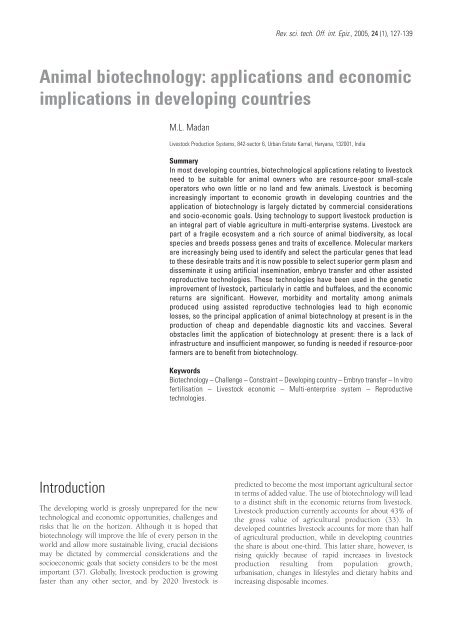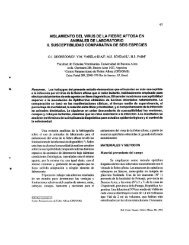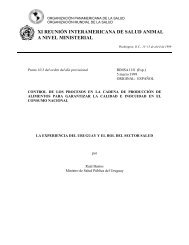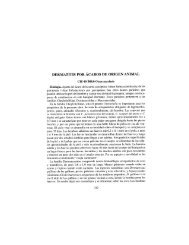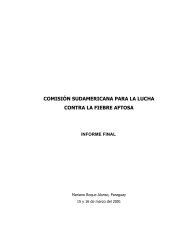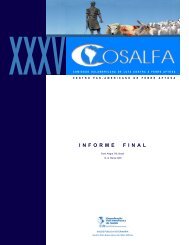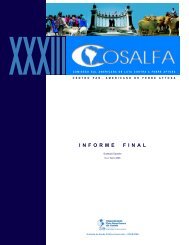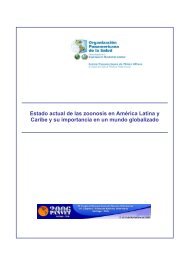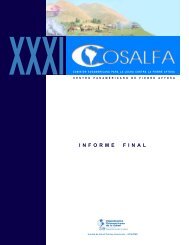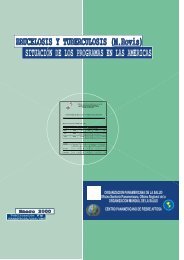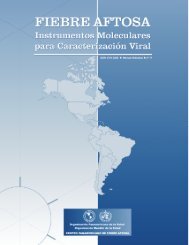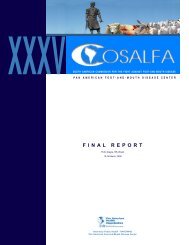Animal biotechnology: applications and economic implications in ...
Animal biotechnology: applications and economic implications in ...
Animal biotechnology: applications and economic implications in ...
Create successful ePaper yourself
Turn your PDF publications into a flip-book with our unique Google optimized e-Paper software.
Rev. sci. tech. Off. <strong>in</strong>t. Epiz., 24 (1) 131develop strategies for marker assisted selection <strong>and</strong> markerassisted <strong>in</strong>trogression that will meet the goals of breed<strong>in</strong>gprogrammes <strong>in</strong> develop<strong>in</strong>g countries. Molecular markershave been widely used <strong>in</strong> the identification of genotypes<strong>and</strong> the ‘genetic f<strong>in</strong>gerpr<strong>in</strong>t<strong>in</strong>g’ of organisms. Genotypeverification is used <strong>in</strong>tensively to determ<strong>in</strong>e the parentageof domestic animals <strong>and</strong> to trace livestock products <strong>in</strong> thefood cha<strong>in</strong> back to the farm <strong>and</strong> animal of orig<strong>in</strong>.Reproductive technologiesThe ma<strong>in</strong> objectives of us<strong>in</strong>g reproductive biotechnologies<strong>in</strong> livestock are to <strong>in</strong>crease production, reproductiveefficiency <strong>and</strong> rates of genetic improvement. Over theyears, many options have become available for manag<strong>in</strong>gthe reproduction of the major large <strong>and</strong> small rum<strong>in</strong>ants.Artificial <strong>in</strong>sem<strong>in</strong>ation (AI) <strong>and</strong> preservation of semen arethe ma<strong>in</strong> technologies that are used extensively. Assess<strong>in</strong>gthe fertilisation capacity of sperms, sex<strong>in</strong>g sperms,synchronisation <strong>and</strong> fixed-time <strong>in</strong>sem<strong>in</strong>ation,superovulation, embryo transfer (ET) <strong>and</strong> <strong>in</strong> vitro embryoproduction (IVEP) are additional techniques that canimprove reproductive efficiency <strong>and</strong> pregnancy rates.Reproductive technologies can also be used to controlreproductive diseases if procedures <strong>and</strong> protocols areaccurately followed (38).Artificial <strong>in</strong>sem<strong>in</strong>ationThe conception rate <strong>in</strong> field AI programmes <strong>in</strong> develop<strong>in</strong>gcountries is very low, <strong>and</strong> therefore the desired effect <strong>in</strong> termsof animal improvement has not been achieved. Most semenbanks still evaluate semen on the basis of sperm motility,even though significant advances have been made <strong>in</strong>techniques for semen evaluation. Although detailedguidel<strong>in</strong>es are available regard<strong>in</strong>g the process<strong>in</strong>g, storage <strong>and</strong>thaw<strong>in</strong>g of cattle semen (67) <strong>and</strong> buffalo semen (58), theprocess<strong>in</strong>g <strong>and</strong> h<strong>and</strong>l<strong>in</strong>g procedures <strong>in</strong> laboratoriesprocess<strong>in</strong>g semen are often <strong>in</strong>adequate. Only when farmershave access to considerably better technical <strong>and</strong>organisational facilities will AI become more effective. Atpresent, the efficiency of the technology is limited byorganisational <strong>and</strong> logistical constra<strong>in</strong>ts <strong>and</strong> by the failure toprovide appropriate tra<strong>in</strong><strong>in</strong>g for farmers. Severalmodifications of the technique have been suggested to<strong>in</strong>crease the conception rate. Synchronisation with differentcompounds, <strong>and</strong> the use of gonadotrop<strong>in</strong>-releas<strong>in</strong>g hormone(GnRH) followed seven days later by prostagl<strong>and</strong><strong>in</strong> F2 α(PGF2 α ) can synchronise oestrus <strong>and</strong> improves theconception rate (59). In this protocol giv<strong>in</strong>g <strong>in</strong>jections ofGnRH on day 0, PGF2 α on day 7 <strong>and</strong> GnRH on day 9 iscalled the ‘Ovsynch’ programme <strong>and</strong> synchronises ovulation,permitt<strong>in</strong>g timed <strong>in</strong>sem<strong>in</strong>ation. The ability to control ovarianfollicular <strong>and</strong> corpus luteum development has allowed<strong>in</strong>sem<strong>in</strong>ation <strong>in</strong> cattle to be timed without hav<strong>in</strong>g to detectoestrus, <strong>and</strong> this has <strong>in</strong>creased the net revenue per cow.Embryo transferOne of the major reproductive technologies that canfacilitate genetic improvement <strong>in</strong> cattle is ET.Unfortunately, commercial ET programmes are limited bythe high variability <strong>in</strong> the ovarian follicular response togonadotrop<strong>in</strong> stimulation. Multiple ovulation <strong>and</strong> embryotransfer (MOET) takes AI one step further, <strong>in</strong> terms of boththe possible genetic ga<strong>in</strong>s <strong>and</strong> the level of technicalexpertise <strong>and</strong> organisation required. In 2001,450,000 embryos were transferred globally, ma<strong>in</strong>ly <strong>in</strong> dairycattle, with 62% be<strong>in</strong>g transferred <strong>in</strong> North America <strong>and</strong>Europe, 16% <strong>in</strong> South America <strong>and</strong> 11% <strong>in</strong> Asia. The ma<strong>in</strong>potential advantage of MOET for develop<strong>in</strong>g countries isthat the elite females of local breeds can be identified, <strong>and</strong>bulls can be produced from them for use <strong>in</strong> a fieldprogramme of breed improvement.Zebu cattle <strong>and</strong> buffaloes <strong>in</strong> develop<strong>in</strong>g countries exhibitless consistent follicular dynamics after superovulationthan Bos taurus <strong>in</strong> the developed world (2). However, overthe last 10 to 15 years, the number of transferable embryosproduced by zebu donors has <strong>in</strong>creased from 2.4 to5.8 embryos per flush <strong>in</strong> the late 1980s to 5.6 to9.9 embryos per flush <strong>in</strong> 2000 (2). The use of ET (46, 61)has been less successful than envisaged for several reasons.The low reproductive efficiency (60), poor superovulatoryresponses (43), very low primordial follicle population <strong>and</strong>high <strong>in</strong>cidence of atresia (39) all contribute to low embryoproduction. In buffaloes, embryo recovery was <strong>in</strong>itially lessthan one, but has subsequently improved to 2.6 with1.4 transferable embryos per flush (40). After transferr<strong>in</strong>gbuffalo embryos to recipients, the conception rate is only16% (61). The poor success rates have limited the use ofET <strong>in</strong> buffaloes, which are the ma<strong>in</strong> dairy animals <strong>in</strong>develop<strong>in</strong>g countries <strong>in</strong> Asia, South-East Asia <strong>and</strong> theMediterranean region.In vitro production of embryosS<strong>in</strong>ce the birth of the first buffalo calf from an <strong>in</strong> vitrofertilised oocyte (40), a number of publications havedescribed the effects of different protocols <strong>and</strong> media onoocyte <strong>and</strong> embryo development. Two extensive reviewshave been published recently (26, 48). However, thepractical use of IVEP is limited by high production costs<strong>and</strong> the low overall efficiency under field conditions. Highrates of maturation (70% to 90%), fertilisation (60% to70%) <strong>and</strong> cleavage (40% to 50%), <strong>and</strong> moderate to lowrates of blastocyst formation (15% to 30%) <strong>and</strong> calfproduction (10.5%) have been reported <strong>in</strong> the literature(48). The efficiency of blastocyst production <strong>in</strong> buffaloes ismuch poorer than the 30% to 60% reported for cattle (20).Although viable buffalo blastocysts have been producedfrom ovaries obta<strong>in</strong>ed from abattoirs (41, 42), the yield oftransferable embryos rema<strong>in</strong>s low (15% to 39%)(9, 10, 11, 47, 48). Embryos produced <strong>in</strong> vitro have ledsuccessfully to pregnancy <strong>and</strong> calf birth <strong>in</strong> buffalo
132Rev. sci. tech. Off. <strong>in</strong>t. Epiz., 24 (1)(9, 25, 41), but the success rate is low. Therefore IVEPmust be improved before it can be widely used <strong>in</strong> cattle<strong>and</strong> buffaloes <strong>in</strong> develop<strong>in</strong>g countries.Improv<strong>in</strong>g health through develop<strong>in</strong>g vacc<strong>in</strong>esMost biotechnologies related to health focus on the needsof the developed world, mean<strong>in</strong>g that 90% of healthresearch is devoted to the health problems of 10% of theworld’s population (12). Two ma<strong>in</strong> approaches are be<strong>in</strong>gused to develop vacc<strong>in</strong>es us<strong>in</strong>g recomb<strong>in</strong>ant DNAtechnology. The first <strong>in</strong>volves delet<strong>in</strong>g genes that determ<strong>in</strong>ethe virulence of the pathogen, thus produc<strong>in</strong>g attenuatedorganisms (non-pathogens) that can be used as livevacc<strong>in</strong>es. Currently, this strategy is more effective aga<strong>in</strong>stviral <strong>and</strong> bacterial diseases than aga<strong>in</strong>st parasites.Attenuated live vacc<strong>in</strong>es have been developed aga<strong>in</strong>st theherpes viruses that cause pseudorabies <strong>in</strong> pigs <strong>and</strong><strong>in</strong>fectious bov<strong>in</strong>e rh<strong>in</strong>otracheitis <strong>in</strong> cattle. A number ofc<strong>and</strong>idate Salmonella vacc<strong>in</strong>es have also been produced.The second approach is to identify prote<strong>in</strong> subunits ofpathogens that can stimulate immunity. The InternationalLivestock Research Institute (ILRI) used this approach todevelop a vacc<strong>in</strong>e aga<strong>in</strong>st Theileria parva, the parasite thatcauses East Coast fever <strong>in</strong> African cattle.A novel strategy for develop<strong>in</strong>g vacc<strong>in</strong>es aga<strong>in</strong>st bloodsuck<strong>in</strong>gparasites <strong>in</strong>volves us<strong>in</strong>g components of the gutwall of the parasite that are not usually exposed to theimmune system of the host. When the parasite feeds, it<strong>in</strong>gests antibodies <strong>in</strong>duced by the vacc<strong>in</strong>e, which destroythe gut wall <strong>and</strong>, consequently, kill the parasite. Thisstrategy has been used successfully to develop a vacc<strong>in</strong>eaga<strong>in</strong>st the one-host tick Boophilus microplus.Vacc<strong>in</strong>ation is one of the most effective <strong>and</strong> susta<strong>in</strong>ablemethods of controll<strong>in</strong>g disease (33, 34). Vacc<strong>in</strong>es aga<strong>in</strong>stparasitic diseases <strong>in</strong> Africa <strong>and</strong> viral diseases <strong>in</strong> Asia havebeen shown to control disease effectively <strong>and</strong> <strong>in</strong>creaselivestock productivity. A recent approach has been to usevacc<strong>in</strong>es based on DNA (66). The use of DNA <strong>in</strong> vacc<strong>in</strong>esis based on the discovery that <strong>in</strong>ject<strong>in</strong>g genes <strong>in</strong> the formof plasmid DNA can stimulate an immune response to therespective gene products. This immune response is a resultof the genes be<strong>in</strong>g taken up <strong>and</strong> expressed by cells <strong>in</strong> theanimal after <strong>in</strong>jection. The live-vector <strong>and</strong> DNAvacc<strong>in</strong>ation systems could be manipulated further toenhance the immunity conferred by the gene products.Experimental studies have demonstrated that thesevacc<strong>in</strong>es can potentially <strong>in</strong>duce appropriate <strong>and</strong> endur<strong>in</strong>gimmune responses. This technology is, <strong>in</strong> pr<strong>in</strong>ciple, one ofthe simplest <strong>and</strong> yet most versatile methods of <strong>in</strong>duc<strong>in</strong>gboth humeral <strong>and</strong> cellular immune responses, as well asprotect<strong>in</strong>g aga<strong>in</strong>st a variety of <strong>in</strong>fectious agents. However,although immune responses have been <strong>in</strong>duced <strong>in</strong> anumber of larger species, most of the <strong>in</strong>formation on theefficacy of DNA immunisation comes from studies of mice.An exhaustive review of the <strong>in</strong>formation available on theuse of DNA vacc<strong>in</strong>es <strong>in</strong> farm animals, <strong>in</strong>clud<strong>in</strong>g cattle, pigs<strong>and</strong> poultry, has identified the areas that need specificattention before this technology can be used rout<strong>in</strong>ely (37).These areas <strong>in</strong>clude the delivery, safety <strong>and</strong> compatibility ofplasmids <strong>in</strong> multivalent vacc<strong>in</strong>es <strong>and</strong> the potential forus<strong>in</strong>g immune stimulants as part of a DNA vacc<strong>in</strong>e. Koreanscientists have developed a comb<strong>in</strong>ed vacc<strong>in</strong>e aga<strong>in</strong>stpleuropneumonia, pneumonic pasteurellosis <strong>and</strong> enzooticpneumonia <strong>in</strong> sw<strong>in</strong>e (50). Molecular biology has been usedto produce an improved vacc<strong>in</strong>e aga<strong>in</strong>st sw<strong>in</strong>e fever. In thePhilipp<strong>in</strong>es, a vacc<strong>in</strong>e has been developed that protectscattle <strong>and</strong> water buffalo aga<strong>in</strong>st haemorrhagic septicaemia,which is the lead<strong>in</strong>g cause of death <strong>in</strong> these animals.The new vacc<strong>in</strong>e provides improved protection at a verylow cost.Diagnostics <strong>and</strong> epidemiologyAdvanced diagnostic tests that use <strong>biotechnology</strong> enablethe agents caus<strong>in</strong>g disease to be identified <strong>and</strong> the impactof disease control programmes to be monitored moreprecisely than was previously possible. Molecularepidemiology characterises pathogens (viruses, bacteria,parasites <strong>and</strong> fungi) by nucleotide sequenc<strong>in</strong>g, enabl<strong>in</strong>gtheir orig<strong>in</strong>s to be traced. This is particularly important forepidemic diseases, <strong>in</strong> which p<strong>in</strong>po<strong>in</strong>t<strong>in</strong>g the source of the<strong>in</strong>fection can significantly improve disease control. Forexample, the molecular analysis of r<strong>in</strong>derpest viruses hasbeen vital <strong>in</strong> determ<strong>in</strong><strong>in</strong>g the l<strong>in</strong>eages circulat<strong>in</strong>g <strong>in</strong> theworld <strong>and</strong> <strong>in</strong>strumental <strong>in</strong> aid<strong>in</strong>g the Global R<strong>in</strong>derpestEradication Programme. Enzyme-l<strong>in</strong>ked immunosorbentassays have become the st<strong>and</strong>ard means of diagnos<strong>in</strong>g <strong>and</strong>monitor<strong>in</strong>g many animal <strong>and</strong> fish diseases worldwide, <strong>and</strong>the PCR technique is especially useful <strong>in</strong> diagnos<strong>in</strong>glivestock disease.Many diagnostic techniques currently used <strong>in</strong> develop<strong>in</strong>gcountries are cumbersome <strong>and</strong> unsuitable for low-resourcesett<strong>in</strong>gs. Molecular diagnostic technologies that are eitheralready <strong>in</strong> use or be<strong>in</strong>g tested <strong>in</strong> low-<strong>in</strong>come regions<strong>in</strong>clude polymerase cha<strong>in</strong> reaction (PCR), monoclonalantibodies <strong>and</strong> recomb<strong>in</strong>ant antigens. These technologiescan be modified to facilitate their application <strong>in</strong> thedevelop<strong>in</strong>g world (12). Simple h<strong>and</strong>-held devices that relyon the b<strong>in</strong>d<strong>in</strong>g specificity of monoclonal antibodies orrecomb<strong>in</strong>ant antigens to diagnose <strong>in</strong>fection may be easilyadapted for use <strong>in</strong> sett<strong>in</strong>gs without runn<strong>in</strong>g water,refrigeration or electricity.Molecular characterisation of the virus serotypes caus<strong>in</strong>gfoot <strong>and</strong> mouth disease has helped <strong>in</strong> the vacc<strong>in</strong>ation <strong>and</strong>control programmes <strong>in</strong> Asia. In Japan <strong>and</strong> Taiwan, DNAtest<strong>in</strong>g is be<strong>in</strong>g used to diagnose hereditary weaknesses oflivestock (50). One test looks for the presence of the gene
Rev. sci. tech. Off. <strong>in</strong>t. Epiz., 24 (1) 133responsible for porc<strong>in</strong>e stress syndrome <strong>in</strong> pigs. Pigs withthis gene tend to produce pale poor-quality meat becauseof their reaction to the stress of transport <strong>and</strong> slaughter.Pigs with this gene can now be excluded from breed<strong>in</strong>gprogrammes, so the gene will become less common. Inaddition, DNA test<strong>in</strong>g is be<strong>in</strong>g used <strong>in</strong> Japan to check forthe gene that causes leucocyte adhesion deficiency <strong>in</strong>Holste<strong>in</strong> cattle. Cattle with this condition suffer from gumdisease, tooth loss <strong>and</strong> stunted growth. They usually diebefore they are one year old. By us<strong>in</strong>g DNA test<strong>in</strong>g, carrierscan be identified <strong>and</strong> elim<strong>in</strong>ated from breed<strong>in</strong>g herds. Bullsused for breed<strong>in</strong>g can also be tested to make sure that theyare not carriers. Another DNA test identifies a gene thatleads to anaemia <strong>and</strong> retarded growth <strong>in</strong> JapaneseBlack cattle.Nutrition <strong>and</strong> feed utilisationThe shortage of feed <strong>in</strong> most develop<strong>in</strong>g countries <strong>and</strong> the<strong>in</strong>creas<strong>in</strong>g cost of feed <strong>in</strong>gredients mean that there is aneed to improve feed utilisation. Aids to animal nutrition,such as enzymes, probiotics, s<strong>in</strong>gle-cell prote<strong>in</strong>s <strong>and</strong>antibiotics <strong>in</strong> feed, are already widely used <strong>in</strong> <strong>in</strong>tensiveproduction systems worldwide to improve the nutrientavailability of feeds <strong>and</strong> the productivity of livestock.Gene-based technologies are be<strong>in</strong>g <strong>in</strong>creas<strong>in</strong>gly used toimprove animal nutrition, either through modify<strong>in</strong>g thefeeds to make them more digestible or through modify<strong>in</strong>gthe digestive <strong>and</strong> metabolic systems of the animals toenable them to make better use of the available feeds(3, 27). Feeds derived from GM plants (a quarter of whichare now grown <strong>in</strong> develop<strong>in</strong>g countries), such as gra<strong>in</strong>,silage <strong>and</strong> hay, have contributed to <strong>in</strong>creases <strong>in</strong> growthrates <strong>and</strong> milk yield. Genetically modified crops withimproved am<strong>in</strong>o acid profiles can be used to decreasenitrogen excretion <strong>in</strong> pigs <strong>and</strong> poultry. Increas<strong>in</strong>g the levelsof am<strong>in</strong>o acids <strong>in</strong> gra<strong>in</strong> means that the essential am<strong>in</strong>o acidrequirements of pigs <strong>and</strong> poultry can be met by diets thatare lower <strong>in</strong> prote<strong>in</strong>.Metabolic modifiers have also been used to <strong>in</strong>creaseproduction efficiency (weight ga<strong>in</strong> or milk yield per feedunit), improve carcass composition (meat-fat ratio),<strong>in</strong>crease milk yield <strong>and</strong> decrease animal fat. The use ofrecomb<strong>in</strong>ant bov<strong>in</strong>e somatotrop<strong>in</strong> (rBST) <strong>in</strong> dairy cows<strong>in</strong>creases both milk yield <strong>and</strong> production efficiency <strong>and</strong>decreases animal fat. In the USA, the use of rBST typically<strong>in</strong>creases milk yield by 10% to 15%. Although trialsconducted <strong>in</strong> develop<strong>in</strong>g countries have reported a similarpercentage <strong>in</strong>crease, this <strong>in</strong>crease is not significant becauseof the low milk yields <strong>and</strong> the high cost-benefit ratio.However, rBST is be<strong>in</strong>g used commercially <strong>in</strong> 19 countrieswhere the <strong>economic</strong> returns make its use worthwhile. Aporc<strong>in</strong>e somatotrop<strong>in</strong> has been developed that <strong>in</strong>creasesmuscle growth <strong>and</strong> reduces body-fat deposition, result<strong>in</strong>g<strong>in</strong> pigs that are leaner <strong>and</strong> of greater market value.Constra<strong>in</strong>ts on apply<strong>in</strong>g thetechnologyThe application of new molecular biotechnologies <strong>and</strong> newbreed<strong>in</strong>g strategies to the livestock breeds used <strong>in</strong>smallholder production systems <strong>in</strong> develop<strong>in</strong>g countries isconstra<strong>in</strong>ed by a number of factors. In the develop<strong>in</strong>gworld, poverty, malnutrition, disease, poor hygiene <strong>and</strong>unemployment are widespread, <strong>and</strong> biotechnologies mustbe able to be applied <strong>in</strong> this context. Over the last fewdecades, the green revolution has brought comparativeprosperity to farmers with l<strong>and</strong>, but the majority offarmers, who are l<strong>and</strong>less or marg<strong>in</strong>al farmers <strong>and</strong> subsistonly on livestock, have been neglected <strong>and</strong> rema<strong>in</strong> poor.The major constra<strong>in</strong>ts on apply<strong>in</strong>g biotechnologies havebeen enumerated by Madan (39) <strong>and</strong> <strong>in</strong>clude:a) the absence of an accurate <strong>and</strong> complete database onlivestock <strong>and</strong> animal owners so that programmes can beimplementedb) the biodiversity present with<strong>in</strong> species <strong>and</strong> breeds <strong>in</strong>agro-ecological systemsc) the fact that models of biotechnological <strong>in</strong>terventiondiffer dist<strong>in</strong>ctly between developed <strong>and</strong> develop<strong>in</strong>geconomiesd) the fact that many animal species <strong>and</strong> breeds are uniqueto the develop<strong>in</strong>g world; each has its own dist<strong>in</strong>ctdevelopmental, production, disease resistance <strong>and</strong> nutrientutilisation characteristicse) the lack of tra<strong>in</strong>ed scientists, technicians <strong>and</strong>fieldworkers to develop <strong>and</strong> apply the technologies, both<strong>in</strong> the government <strong>and</strong> <strong>in</strong> the private sectorsf) the absence of an <strong>in</strong>terface between <strong>in</strong>dustry,universities <strong>and</strong> <strong>in</strong>stitutions, which is necessary to translatetechnologies <strong>in</strong>to productsg) the <strong>in</strong>ability to access technologies from the developedworld at an affordable price <strong>in</strong> order to make a rightful,positive <strong>and</strong> susta<strong>in</strong>able contribution to livestockproduction <strong>and</strong> the <strong>economic</strong> welfare of farmersh) the high cost of technological <strong>in</strong>puts such as materials,biologicals <strong>and</strong> equipmenti) the failure to address issues of biosafety <strong>and</strong> to conductrisk analyses of new biologicals, gene products, transgenics<strong>and</strong> modified food items, <strong>and</strong>, above allj) the negligible <strong>in</strong>vestment <strong>in</strong> animal <strong>biotechnology</strong>.The critical issues affect<strong>in</strong>g livestock productivity haverecently been re-exam<strong>in</strong>ed. Research that aims to enhanceproductivity <strong>and</strong> susta<strong>in</strong>ability should focus on improv<strong>in</strong>g
134Rev. sci. tech. Off. <strong>in</strong>t. Epiz., 24 (1)livestock feeds <strong>and</strong> nutrition, improv<strong>in</strong>g animal health,manag<strong>in</strong>g natural resources relat<strong>in</strong>g to the livestock sector,asses<strong>in</strong>g the impact of technological <strong>in</strong>terventions, <strong>and</strong>strengthen<strong>in</strong>g the capacity of the national agriculturalresearch systems of develop<strong>in</strong>g countries (24).Furthermore, the potential production capacity <strong>and</strong>contribution of livestock to the economy are still not be<strong>in</strong>gachieved <strong>in</strong> develop<strong>in</strong>g countries because the transfer,adaptation <strong>and</strong> adoption of technology is hampered by thelack of a clear policy for livestock development that isconducive to the <strong>in</strong>troduction of new proven technology<strong>and</strong> by the lack of <strong>in</strong>formation flow from <strong>and</strong> todecision makers.In develop<strong>in</strong>g countries, there is a wealth gap betweenurban <strong>and</strong> rural areas, which persists <strong>and</strong> may even bewiden<strong>in</strong>g; the rural-urban divide also tends to be reflected<strong>in</strong> education <strong>and</strong> health <strong>in</strong>dicators (23). In addition,women <strong>in</strong> rural (<strong>and</strong> urban) areas who are predom<strong>in</strong>antly<strong>in</strong>volved <strong>in</strong> animal husb<strong>and</strong>ry have higher illiteracy ratesthan men (21). A survey of 21 African countries recentlyhighlighted the substantial disparities <strong>in</strong> primary school<strong>in</strong>gbetween urban <strong>and</strong> rural areas, <strong>in</strong> favour of urban dwellers.Special attention must be given to the knowledge <strong>and</strong><strong>in</strong>formation needed to enable rural people to apply<strong>biotechnology</strong>. There is a need to identify alternativedelivery systems (beyond the State) for animal healthcare<strong>and</strong> to propose new roles for the state <strong>and</strong> the privatesector <strong>in</strong> service delivery.Build<strong>in</strong>g capacityOw<strong>in</strong>g to the constra<strong>in</strong>ts outl<strong>in</strong>ed above, the <strong>economic</strong>benefits of animal <strong>biotechnology</strong> cannot be realisedwithout a conscious, susta<strong>in</strong>ed, holistic, multi-stakeholder,participatory approach. There is a great need to ensure thatcapacity is not just created but also is reta<strong>in</strong>ed <strong>and</strong>enhanced. Capacity-build<strong>in</strong>g activities must be carried outat all levels: the awareness of policy <strong>and</strong> decision makersmust be raised, the necessary legal <strong>and</strong> regulatoryframeworks must be <strong>in</strong>itiated, the technical <strong>and</strong> regulatorycapacities must be enhanced <strong>and</strong> <strong>in</strong>stitutions may need tobe overhauled. More importantly, it is necessary to assess<strong>and</strong> deploy competent operators <strong>and</strong> <strong>in</strong>stitutional capacitycont<strong>in</strong>uously so that, as <strong>biotechnology</strong> advances, theprocedures required for its safe use can be constantlyevaluated, upgraded <strong>and</strong> applied. This is a daunt<strong>in</strong>g task,but it can be achieved through firm commitment <strong>and</strong>partnerships.Fund<strong>in</strong>g to implement technologyDevelop<strong>in</strong>g <strong>and</strong> commercialis<strong>in</strong>g improved technologies <strong>in</strong>most develop<strong>in</strong>g countries has been the responsibility ofthe public sector, <strong>and</strong> technology has been dissem<strong>in</strong>atedfreely (51). This situation will have to cont<strong>in</strong>ue if superiorgenetics, diagnostics <strong>and</strong> vacc<strong>in</strong>es are to be delivered.However, research <strong>and</strong> almost all commercial developmentof <strong>biotechnology</strong> <strong>in</strong> the developed world are be<strong>in</strong>g drivenlargely by the private sector (52).The global trends <strong>in</strong> fund<strong>in</strong>g for research <strong>and</strong> development<strong>and</strong> production do not address the concerns, needs <strong>and</strong>opportunities of the develop<strong>in</strong>g world. Develop<strong>in</strong>gcountries are f<strong>in</strong>d<strong>in</strong>g it <strong>in</strong>creas<strong>in</strong>gly expensive to access<strong>and</strong> use new technologies. There is limited private- <strong>and</strong>public-sector <strong>in</strong>vestment <strong>in</strong> animal health <strong>and</strong> production,particularly <strong>in</strong> relation to modern biotechnologies that are‘resource hungry’. Although several discoveries have beenmade <strong>in</strong> laboratories <strong>in</strong> the develop<strong>in</strong>g world, <strong>in</strong> mostcases these have not been converted <strong>in</strong>to usefultechnologies or products. The key potential users –resource-poor often illiterate farmers with a limitedknowledge base – do not feel that apply<strong>in</strong>g thesetechnologies is worth the effort, cost <strong>and</strong> risk <strong>in</strong>volved.This is ma<strong>in</strong>ly because there is no agency or <strong>in</strong>dustry thatcan scale up <strong>and</strong> package the technology. Also, <strong>in</strong> thedeveloped world, there is an <strong>economic</strong> <strong>in</strong>centive to marketbiotechnological services <strong>and</strong> products; this is lack<strong>in</strong>g <strong>in</strong>the develop<strong>in</strong>g world because of the limited purchas<strong>in</strong>gpower of resource-poor stakeholders. Research <strong>in</strong><strong>biotechnology</strong> <strong>in</strong> recent years has also been motivated by<strong>economic</strong> considerations, <strong>and</strong> little research is conducted<strong>in</strong> the develop<strong>in</strong>g world because of the probable lack ofreturns on the <strong>in</strong>vestment. For underst<strong>and</strong>able reasons,current fund<strong>in</strong>g policies <strong>in</strong> develop<strong>in</strong>g countries focus onareas that will yield practical benefit <strong>in</strong> the short term. Indeterm<strong>in</strong><strong>in</strong>g future policy, policy-makers <strong>and</strong> fund<strong>in</strong>gbodies must not lose sight of the substantial benefits thatcan be ga<strong>in</strong>ed <strong>in</strong> the longer term by <strong>in</strong>vest<strong>in</strong>g <strong>in</strong> strategicresearch <strong>in</strong>to vacc<strong>in</strong>e development.Adequate multi-<strong>in</strong>stitutional (national <strong>and</strong> <strong>in</strong>ternational)support through an <strong>in</strong>ternational donor consortium isneeded to develop cost-effective, cheap <strong>and</strong> easilyadaptable biotechnological products. The amount spent by<strong>in</strong>ternational agencies on animal <strong>biotechnology</strong> <strong>in</strong>develop<strong>in</strong>g countries is currently very low <strong>and</strong> constitutesonly a small percentage of the total spend<strong>in</strong>g onagriculture. The World Bank, the Food <strong>and</strong> AgricultureOrganization, the Consultative Group on InternationalAgricultural Research, the United Nations DevelopmentProgramme, the United States Agency for InternationalDevelopment, the Swedish International DevelopmentCooperation Agency, the International DevelopmentResearch Centre, the Asian Development Bank <strong>and</strong> otherdonor <strong>and</strong> fund<strong>in</strong>g agencies have to designate a higherpercentage of funds to the livestock sector (39). It has beenconv<strong>in</strong>c<strong>in</strong>gly shown that <strong>in</strong>vest<strong>in</strong>g <strong>in</strong> livestockhas a dramatic <strong>and</strong> far-reach<strong>in</strong>g impact on thehuman development <strong>in</strong>dex. This is a strong argument <strong>in</strong>
Rev. sci. tech. Off. <strong>in</strong>t. Epiz., 24 (1) 135favour of <strong>in</strong>vest<strong>in</strong>g heavily <strong>in</strong> animal production <strong>and</strong>health biotechnologies <strong>in</strong> order to br<strong>in</strong>g <strong>economic</strong>prosperity, nutritional security, rural development <strong>and</strong>health improvements to poor populations <strong>in</strong> thedevelop<strong>in</strong>g world.ConclusionsAlthough animal production is be<strong>in</strong>g changed significantlyby advances made <strong>in</strong> thous<strong>and</strong>s of <strong>biotechnology</strong>laboratories around the world, benefits are reach<strong>in</strong>g thedevelop<strong>in</strong>g world <strong>in</strong> only a few areas of conservation,animal improvement, healthcare (<strong>in</strong>clud<strong>in</strong>g diagnosis <strong>and</strong>control of disease) <strong>and</strong> the augmentation of feed resources.Adopt<strong>in</strong>g <strong>biotechnology</strong> has resulted <strong>in</strong> dist<strong>in</strong>ct benefits <strong>in</strong>terms of animal improvement <strong>and</strong> <strong>economic</strong> returns to thefarmers. Over the past decade, the ILRI has focused onbiotechnological <strong>applications</strong>, especially <strong>in</strong> Africa, <strong>and</strong>several develop<strong>in</strong>g countries now have multi-<strong>in</strong>stitutionalprogrammes to develop <strong>and</strong> apply <strong>biotechnology</strong>. Thedevelop<strong>in</strong>g world will have to respond to the many genebasedtechnologies now be<strong>in</strong>g developed with a sense ofcommitment, tra<strong>in</strong>ed manpower, <strong>in</strong>frastructure <strong>and</strong>fund<strong>in</strong>g.Biotechnologie animale : <strong>applications</strong> et <strong>implications</strong>économiques dans les pays en développementM.L. MadanRésuméDans la plupart des pays en développement, les <strong>applications</strong> biotechnologiquesconcernant l’élevage doivent être accessibles aux éleveurs dont l’exploitationest de petite taille et dont les ressources sont limitées, qui possèdent quelquesanimaux et peu ou pas de terres. Or le bétail devient de plus en plus importantpour la croissance économique des pays en développement et l’application de labiotechnologie est en gr<strong>and</strong>e partie dictée par des considérations commercialeset des objectifs socio-économiques. Le recours à la technologie pour soutenir laproduction animale fait partie <strong>in</strong>tégrante d’une agriculture viable dans le cadrede systèmes de production diversifiés multi-entreprises. Les animaux d’élevagefont partie d’un écosystème fragile et constituent une source importante debiodiversité animale puisque les espèces et les races locales possèdent desgènes et des caractères d’excellence. Les marqueurs moléculaires sont de plusen plus utilisés pour identifier et sélectionner les gènes qui déterm<strong>in</strong>ent cescaractères recherchés et il est désormais possible de sélectionner ungermoplasme supérieur et de le dissém<strong>in</strong>er par <strong>in</strong>sém<strong>in</strong>ation artificielle, partransfert d’embryon et autres techniques de reproduction assistée. Cestechnologies ont été employées pour l’amélioration génétique du bétail, enparticulier des bov<strong>in</strong>s et des buffles, et leurs bénéfices économiques sontimportants. Toutefois, comme la morbidité et la mortalité observées parmi lesanimaux produits par des techniques de reproduction assistée se traduisent parde lourdes pertes économiques, la pr<strong>in</strong>cipale application de la biotechnologieanimale est actuellement axée sur la production de kits de diagnostic et devacc<strong>in</strong>s peu coûteux et fiables. Plusieurs obstacles limitent aujourd’huil’application de la biotechnologie : le manque d’<strong>in</strong>frastructures et les ressourceshuma<strong>in</strong>es <strong>in</strong>suffisantes. Des f<strong>in</strong>ancements sont donc nécessaires pour que leséleveurs disposant de ressources limitées puissent bénéficier de labiotechnologie.Mots-clésBiotechnologie – Contra<strong>in</strong>te – Défi – Économie de l’élevage – Fécondation <strong>in</strong> vitro – Paysen développement – Système multi-entreprises – Techniques de la reproduction.
136Rev. sci. tech. Off. <strong>in</strong>t. Epiz., 24 (1)Aplicaciones de la biotecnología al mundo animal y repercusioneseconómicas en los países en desarrolloM.L. MadanResumenEn la mayoría de los países en desarrollo, las aplicaciones de la biotecnologíarelacionadas con el ganado deben ser apropiadas para pequeños propietariosque trabajan con pocos recursos y a pequeña escala, tienen pocos animalesy poseen, en el mejor de los casos, exiguas parcelas de tierra. El ganado bov<strong>in</strong>oes cada vez más importante para el crecimiento económico de los países endesarrollo, y la aplicación de la biotecnología a esos animales está supeditadaen gran medida a consideraciones de rentabilidad y objetivos socioeconómicos.El uso de la biotecnología en apoyo de la producción ganadera forma parte<strong>in</strong>tegral de una agricultura viable en sistemas multiempresariales. Los animalesforman parte del frágil ecosistema en el que viven y son un rico reservorio dediversidad biológica, no en vano las especies y razas locales atesoran genesy rasgos de excelencia. Los marcadores moleculares se utilizan cada vez conmás frecuencia para localizar y seleccionar los genes concretos portadores deesos rasgos deseables. Hoy en día ya es posible seleccionar germoplasmasuperior y disem<strong>in</strong>arlo con procedimientos de <strong>in</strong>sem<strong>in</strong>ación artificial,transferencia de embriones y demás técnicas de reproducción asistida. Estastécnicas, que se han utilizado para la mejora genética del ganado, en particularbov<strong>in</strong>os y búfalos, ofrecen un importante rendimiento económico. S<strong>in</strong> embargo,la morbididad y mortalidad de animales obtenidos con técnicas de reproducciónasistida provocan elevadas pérdidas f<strong>in</strong>ancieras, por lo que hoy en díala pr<strong>in</strong>cipal aplicación de la biotecnología al mundo animal es la elaboración devacunas y kits de diagnóstico baratos y fiables. Entre los varios obstáculosque de momento frenan la aplicación de la biotecnología destacan la faltade <strong>in</strong>fraestructura y la escasez de recursos humanos. Para que los granjeroscon pocos recursos puedan beneficiarse de la biotecnología se necesitan porconsiguiente medios f<strong>in</strong>ancieros.Palabras claveBiotecnología – Desafío – Economía ganadera – Fertilización <strong>in</strong> vitro – Limitación – Paísen desarrollo – Sistema multiempresarial – Técnica de reproducción – Transferencia deembriones.References1. Alston J.M., Norton G.W. & Pardey P.G. (1995). – Scienceunder scarcity: pr<strong>in</strong>ciples <strong>and</strong> practice for agriculturalresearch evaluation <strong>and</strong> priority sett<strong>in</strong>g. Cornell UniversityPress, Ithaca, 585 pp.2. Barros C.M. & Nogueira M.F.G. (2001). – Embryo transfer <strong>in</strong>Bos <strong>in</strong>dicus cattle. Theriogenology, 56, 1483-1496.3. Bedford M.R. (2000). – Exogenous enzymes <strong>in</strong> monogastricnutrition: their current value <strong>and</strong> future benefits. Anim. FeedSci. Technol., 86, 1-13.4. Bennett R., Morse S. & Ismael Y. (2003). – The benefits of Btcotton to small-scale producers <strong>in</strong> develop<strong>in</strong>g countries: thecase of South Africa. In 7th ICABR International Conferenceon Public Goods <strong>and</strong> Public Policy for AgriculturalBiotechnology, 29 June-3 July, Ravello. InternationalConsortium on Agricultural Biotechnology Research, Ravello.Website: www.economia.uniroma2.it/conferenze/icabr2003/papers/<strong>in</strong>dex.htm (accessed on 1 June 2005).5. Birthal P.S., Kumar A., Ravi Shankar A. & P<strong>and</strong>ey U.K.(1999). – Sources of growth <strong>in</strong> the livestock sector. Policypaper No. 9. National Centre for Agricultural Economics <strong>and</strong>Policy Research, New Delhi, 58 pp.
Rev. sci. tech. Off. <strong>in</strong>t. Epiz., 24 (1) 1376. Birthal P.S., Joshi P.K. & Kumar A. (2002). – Assessment ofresearch priorities for livestock sector <strong>in</strong> India. Policy paperNo. 15. National Centre for Agricultural Economics <strong>and</strong>Policy Research, New Delhi, 64 pp.7. Byerlee D. & Hesse de Polanco E. (1986). – Farmers’ stepwiseadoption of technological packages: evidence from theMexican Altiplano. Am. J. agric. Econ., 68, 519-527.8. Byerlee D. & Fischer K. (2002). – Access<strong>in</strong>g modern science:policy <strong>and</strong> <strong>in</strong>stitutional options for agricultural <strong>biotechnology</strong><strong>in</strong> develop<strong>in</strong>g countries. World Dev., 30, 931-948.9. Chauhan M.S., S<strong>in</strong>gla S.K., Manik R.S. & Madan M.L.(1997). – Increased capacitation of buffalo sperm by hepar<strong>in</strong>as confirmed by electron microscopy <strong>and</strong> <strong>in</strong> vitro fertilization.Indian J. experim. Biol., 35, 1038-1043.10. Chauhan M.S., S<strong>in</strong>gla S.K., Palta P., Manik R.S. &Madan M.L. (1998). – In vitro maturation <strong>and</strong> fertilization,<strong>and</strong> subsequent development of buffalo (Bubalus bubalis)embryos: effects of oocyte quality <strong>and</strong> type of serum. Reprod.Fertil. Dev., 10, 173-177.11. Chauhan M.S., S<strong>in</strong>gla S.K., Palta P., Manik R.S. &Madan M.L. (1999). – Effect of epidermal growth factor onthe cumulus expansion, meiotic maturation <strong>and</strong> developmentof buffalo oocytes <strong>in</strong> vitro. Vet. Rec., 144, 266-267.12. Daar A.S., Thorste<strong>in</strong>sdottir H., Mart<strong>in</strong> D.K., Smith A.C.,Nast S. & S<strong>in</strong>ger P.A. (2002). – Top ten biotechnologies forimprov<strong>in</strong>g health <strong>in</strong> develop<strong>in</strong>g countries. Nature Genet.,32, 229-232.13. Dastagiri M.B. (2004). – Dem<strong>and</strong> <strong>and</strong> policy projections forlivestock production <strong>in</strong> India. Policy paper No. 21. NationalCentre for Agricultural Economics <strong>and</strong> Policy Research, NewDelhi.14. Delgado C.L., Hopk<strong>in</strong>s J. & Kelly V.A. (1998). – Agriculturalgrowth l<strong>in</strong>kages <strong>in</strong> sub-Saharan Africa. Research ReportNo. 107, International Food Policy Research Institute,Wash<strong>in</strong>gton, DC, 154 pp.15. Denn<strong>in</strong>g C. & Priddle H. (2003). – New frontiers <strong>in</strong> genetarget<strong>in</strong>g <strong>and</strong> clon<strong>in</strong>g: success, application <strong>and</strong> challenges <strong>in</strong>domestic animals <strong>and</strong> human embryonic stem cells.Reproduction, 126, 1-11.16. Dhalm<strong>in</strong>i Z., Spillane C., Moss J.P., Ruane J., Urquia N. &Sonn<strong>in</strong>o A. (2005). – Status of research <strong>and</strong> application ofcrop biotechnologies <strong>in</strong> develop<strong>in</strong>g countries – a prelim<strong>in</strong>aryassessment. Renouf Books, Ogdensburg, New York, 62 pp.17. Dorjee K., Broca S. & P<strong>in</strong>gali P. (2003). – Diversification <strong>in</strong>South Asian agriculture: trends <strong>and</strong> constra<strong>in</strong>ts. ESA Work<strong>in</strong>gpaper 03-15. Food <strong>and</strong> Agriculture Organization, Rome,23 pp.18. Drucker A.G. (2004). – The <strong>economic</strong>s of farm animalgenetic resource conservation <strong>and</strong> susta<strong>in</strong>able use: why is itimportant <strong>and</strong> what have we learned? Background studypaper No. 21. Food <strong>and</strong> Agriculture Organization, Rome,11 pp.19. Fan S., Hazell P. & Thorat S. (1998). – Government spend<strong>in</strong>g,growth <strong>and</strong> poverty: an analysis of <strong>in</strong>terl<strong>in</strong>kages <strong>in</strong> ruralIndia. Environment <strong>and</strong> Production Technology Divisiondiscussion paper No. 33, International Food Policy ResearchInstitute, Wash<strong>in</strong>gton, DC, 92 pp.20. Far<strong>in</strong> P.W., Crosier A.E. & Far<strong>in</strong> C.E. (2001). – Influence of<strong>in</strong> vitro systems on embryo survival <strong>and</strong> fetal development <strong>in</strong>cattle. Theriogenology, 55, 151-170.21. Flavell R. (1999). – Biotechnology <strong>and</strong> food <strong>and</strong> nutritionneeds: <strong>biotechnology</strong> for develop<strong>in</strong>g-country agriculture:problems <strong>and</strong> opportunities, Brief 2 of 10. International FoodPolicy Research Institute, Wash<strong>in</strong>gton, DC, 2 pp.22. Food <strong>and</strong> Agriculture Organization (FAO) (2000). – Theappropriateness, significance <strong>and</strong> application of<strong>biotechnology</strong> options <strong>in</strong> the animal agriculture of develop<strong>in</strong>gcountries. Electronic forum on <strong>biotechnology</strong> <strong>in</strong> food <strong>and</strong>agriculture. Conference 3. FAO, Rome.23. Food <strong>and</strong> Agriculture Organization (FAO) (2004). – TheState of Food <strong>and</strong> Agriculture 2003-2004. Agricultural<strong>biotechnology</strong>: meet<strong>in</strong>g the needs of the poor. FAO, Rome,209 pp.24. Food <strong>and</strong> Agriculture Organization (FAO)/InternationalAtomic Energy Agency (IAEA) (2004). – F<strong>in</strong>al report –<strong>in</strong>ternational symposium on <strong>applications</strong> of gene-basedtechnologies for improv<strong>in</strong>g animal production <strong>and</strong> health <strong>in</strong>develop<strong>in</strong>g countries. FAO/IAEA, Vienna, 21 pp.25. Galli C., Crotti G., Notari C., Tur<strong>in</strong>i P., Duchi R. &Lazzari G. (2001). – Embryo production by ovum pick upfrom live donors. Theriogenology, 55, 1341-1357.26. Gasparr<strong>in</strong>i B. (2002). – In vitro embryo production <strong>in</strong> buffalospecies: state of the art. Theriogenology, 57, 237-256.27. Gordon G.L.R. & Phillips M.W. (1998). – The role ofanaerobic gut fungi <strong>in</strong> rum<strong>in</strong>ants. Nutr. Res. Rev.,11, 133-168.28. Hazell P. & Haggblade S. (1993). – Farm-nonfarm growthl<strong>in</strong>kages <strong>and</strong> the welfare of the poor. In Includ<strong>in</strong>g the poor(M. Lipton & J. van der Gaag, eds). World Bank, Wash<strong>in</strong>gton,DC, 190-204.29. Herdt R.W. (1987). – A retrospective view of technological<strong>and</strong> other changes <strong>in</strong> Philipp<strong>in</strong>e rice farm<strong>in</strong>g 1965-1982.Econ. Dev. cult. Change, 35, 329-349.30. Hobbel<strong>in</strong>k H. (1987). – New hope or false promise?Biotechnology <strong>and</strong> Third World agriculture. InternationalCoalition for Development Action, Brussels, 72 pp.31. Jabbar M.A. & Diedhiou M.L. (2003). – Does breed matter tocattle farmers <strong>and</strong> buyers? Evidence from West Africa.Ecol. Econ., 45, 461-472.32. James C. (2003). – Preview: global status of commercializedtransgenic crops 2003. International Service for theAcquisition of Agri-biotech Applications (ISAAA) BriefsNo. 30. ISAAA, Ithaca, New York, 8 pp.
138Rev. sci. tech. Off. <strong>in</strong>t. Epiz., 24 (1)33. Jutzi S. (2003). – Applications of gene-based technologies forimprov<strong>in</strong>g animal production <strong>and</strong> health <strong>in</strong> develop<strong>in</strong>gcountries. FAO/IAEA International Symposium, Vienna,Austria, 6-10 October 2003. Open<strong>in</strong>g address. Food <strong>and</strong>Agriculture Organization/International Atomic EnergyAgency, Vienna. Website: www.iaea.org/programmes/nafa/d3/public/open<strong>in</strong>g-address-director-fao.pdf.34. Kurstak E. (1999). – Towards new vacc<strong>in</strong>es <strong>and</strong> modernvacc<strong>in</strong>ology: <strong>in</strong>troductory remarks. Vacc<strong>in</strong>e, 17, 1583-1586.35. McDermott J.J., R<strong>and</strong>olph T.F. & Staal S.J. (1999). – The<strong>economic</strong>s of optimal health <strong>and</strong> productivity <strong>in</strong> smallholderlivestock systems <strong>in</strong> develop<strong>in</strong>g countries. In The <strong>economic</strong>sof animal disease control. Rev. sci. tech. Off. <strong>in</strong>t. Epiz.,18 (2), 399-424.36. Ma H., Rae A.N. & Huang J. (2004). – Livestock productivity<strong>in</strong> Ch<strong>in</strong>a: data revision <strong>and</strong> total factor productivitydecomposition, Ch<strong>in</strong>a agriculture work<strong>in</strong>g paper 1/04,Centre for Applied Economics <strong>and</strong> Policy Studies. MasseyUniversity, Palmerston North, 31 pp.37. Macer D.R.J. (1996). – Biotechnology, <strong>in</strong>ternationalcompetition, <strong>and</strong> its <strong>economic</strong> ethical <strong>and</strong> social <strong>implications</strong><strong>in</strong> develop<strong>in</strong>g countries. In Concepts <strong>in</strong> <strong>biotechnology</strong>(D. Balasubramanian, C.F.A. Bryce, K. Dharmal<strong>in</strong>gam,J. Green, K. Jayaraman, ed.). Universities Press Pvt. Ltd.Orient Longman Inc., Hyderabad, 378-397.38. Madan M.L. (2002). – Biotechnologies <strong>in</strong> animalreproduction. Key note address at <strong>in</strong>ternational conferenceon animal <strong>biotechnology</strong>. Tamilnadu Vater<strong>in</strong>ary <strong>and</strong> <strong>Animal</strong>Science University, Chennai.39. Madan M.L. (2003). – Opportunities <strong>and</strong> constra<strong>in</strong>ts forus<strong>in</strong>g gene-based technologies <strong>in</strong> animal agriculture <strong>in</strong>develop<strong>in</strong>g countries <strong>and</strong> possible role of <strong>in</strong>ternational donoragencies <strong>in</strong> promot<strong>in</strong>g R&D <strong>in</strong> this field. In FAO/IAEA<strong>in</strong>ternational symposium on <strong>applications</strong> of gene-basedtechnologies for improv<strong>in</strong>g animal production <strong>and</strong> health <strong>in</strong>develop<strong>in</strong>g countries, Vienna, Austria, 6-10 October 2003.Food <strong>and</strong> Agriculture Organization/International AtomicEnergy Agency, Vienna, 103-104.40. Madan M.L., S<strong>in</strong>gla S.K., Jailkhani S. & Ambrose J.D. (1991).– In vitro fertilization <strong>and</strong> birth of first ever IVF buffalo calf.In Proc. 3rd World Buffalo Congress, Varna, 11-17.41. Madan M.L., S<strong>in</strong>gla S.K., Chauhan M.S. & Manik R.S.(1994). – In vitro production <strong>and</strong> transfer of embryos <strong>in</strong>buffaloes. Theriogenology, 41, 139-143.42. Madan M.L., Chauhan M.S., S<strong>in</strong>gla S.K. & Manik R.S.(1994). – Pregnancies established from water buffalo (Bubalusbubalis) blastocysts derived from <strong>in</strong> vitro matured, <strong>in</strong> vitrofertilized oocytes <strong>and</strong> co-cultured with cumulus <strong>and</strong>oviductal cells. Theriogenology, 42, 591-600.43. Madan M.L., Das S.K. & Palta P. (1996). – Application ofreproductive technology to buffaloes. Anim. Reprod. Sci.,42, 299-306.44. Mellor J.W. (1997). – The new <strong>economic</strong>s of growth: 40 yearsof agricultural development; what is old, what is new. Asian J.Agric. Econ., 2, 123-129.45. Mendelsohn R. (2003). – The challenge of conserv<strong>in</strong>g<strong>in</strong>digenous domesticated animals. Ecol. Econ., 45, 501-510.46. Misra A.K. (1997). – Application of biotechnologies tobuffalo breed<strong>in</strong>g <strong>in</strong> India. In 3rd Course on <strong>biotechnology</strong> ofreproduction <strong>in</strong> buffaloes, Caserta, 141-166.47. N<strong>and</strong>i S., Chauhan M.S. & Palta P. (1998). – Influence ofcumulus cells <strong>and</strong> sperm concentration on cleavage rate <strong>and</strong>subsequent embryonic development of buffalo(Bubalus bubalis) oocytes matured <strong>and</strong> fertilized <strong>in</strong> vitro.Theriogenology, 50, 1251-1262.48. N<strong>and</strong>i S., Raghu H.M., Rav<strong>in</strong>dranatha B.M. & Chauhan M.S.(2002). – Production of buffalo (Bubalus bubalis) embryos <strong>in</strong>vitro: premises <strong>and</strong> promises. Reprod. dom. Anim., 37, 65-74.49. N<strong>in</strong> A., Hertel T.W., Rae A.N. & Ehui S. (2002). –Productivity growth, ‘catch<strong>in</strong>g up’ <strong>and</strong> trade <strong>in</strong> livestockproducts. ILRI Socio-<strong>economic</strong>s <strong>and</strong> policy research work<strong>in</strong>gpaper No. 37. International Livestock Research Institute,Nairobi, 41 pp.50. Oishi T., Cheong I.C., Villar E.C., Lee S.N. & Vajrabukka C.(1999). – Applied <strong>biotechnology</strong> <strong>in</strong> animal production. Issues<strong>in</strong> Asian Agriculture 1999-06-01. Food <strong>and</strong> FertilizerTechnology Center, Taiwan. Website: www.fftc.agnet.org(accessed on 2 June 2005).51. Pal S. & Byerlee D. (2003). – The fund<strong>in</strong>g <strong>and</strong> organizationof agricultural research <strong>in</strong> India: evolution <strong>and</strong> emerg<strong>in</strong>gpolicy issues. Policy paper No. 16. National Centrefor Agricultural Economics <strong>and</strong> Policy Research, New Delhi,29 pp.52. P<strong>in</strong>gali P.L. & Traxler G. (2002). – Chang<strong>in</strong>g locus ofagricultural research: will the poor benefit from<strong>biotechnology</strong> <strong>and</strong> privatization trends? Food Policy,27, 223-238.53. Pray C.E. & Huang J. (2003). – The impact of BT cotton <strong>in</strong>Ch<strong>in</strong>a. In The <strong>economic</strong> <strong>and</strong> environmental impacts ofagbiotech: a global perspective (N. Kalaitz<strong>and</strong>onakes, ed.).Kluwer-Plenum Academic Publishers, New York, 223-242.54. Pray C.E. & Naseem A. (2003). – The <strong>economic</strong>sof agricultural <strong>biotechnology</strong> research. ESA work<strong>in</strong>g paperNo. 03-07. Food <strong>and</strong> Agriculture Organization, Rome, 37 pp.55. Pray C.E. & Naseem A. (2003). – Biotechnology R&D: policyoptions to ensure access <strong>and</strong> benefits for the poor. ESAwork<strong>in</strong>g paper No. 03-08. Food <strong>and</strong> AgricultureOrganization, Rome, 37 pp.56. Rangi P.S. (2004). – Trade <strong>and</strong> policy issues <strong>and</strong> developmentof multi-enterprise agriculture system. Multi-enterprisesystem for viable agriculture (C.L. Acharya, R.K. Gupta,D.N.L. Rao & A. Subba Rao, eds). In Proc. 6th AgriculturalScience Congress, Bhopal, 13-15 February 2003. NationalAcademy of Agricultural Sciences, New Delhi, 315-328.57. Rege J.E.O. & Gibson J.P. (2003). – <strong>Animal</strong> genetic resources<strong>and</strong> <strong>economic</strong> development: issues <strong>in</strong> relation to <strong>economic</strong>valuation. Ecol. Econ., 45, 319-330.
Rev. sci. tech. Off. <strong>in</strong>t. Epiz., 24 (1) 13958. Sansone G., Nastri M.J.F. & Fabbroc<strong>in</strong>i A. (2000). – Storageof buffalo (Bubalus bubalis) semen. Anim. Reprod. Sci.,62, 55-76.59. Schmitt E.J., Diaz T., Drost M. & Thatcher W.W. (1996). –Use of a gonadotrop<strong>in</strong>-releas<strong>in</strong>g hormone agonist or humanchorionic gonadotrop<strong>in</strong> for timed <strong>in</strong>sem<strong>in</strong>ation <strong>in</strong> cattle.J. Anim. Sci., 74, 1084-1091.60. S<strong>in</strong>gh J., N<strong>and</strong>a A.S. & Adams G.P. (2000). – Thereproductive pattern <strong>and</strong> efficiency of female buffaloes.Anim. Reprod. Sci., 60-61, 593-604.61. S<strong>in</strong>gla S.K., Manik R.S. & Madan M.L. (1996). – Embryo<strong>biotechnology</strong> <strong>in</strong> buffaloes: a review. Bubalus bubalis,1, 53-63.62. Taneja V.K. & Birthal P.S. (2004). – <strong>Animal</strong> husb<strong>and</strong>ryentrepreneurship <strong>and</strong> policy support. Multi-enterprisesystem for viable agriculture (C.L. Acharya, R.K. Gupta,D.N.L. Rao & A. Subba Rao, eds). In Proc. 6th AgriculturalScience Congress, Bhopal, 13-15 February 2003. NationalAcademy of Agricultural Sciences, New Delhi, 85-100.64. Traxler G. & Byerlee D. (1992). – Economic returns to cropmanagement research <strong>in</strong> post-green revolution sett<strong>in</strong>g.Am. J. agric. Econ., 74, 573-582.65. Traxler G., Godoy-Avila S., Falck-Zepeda J. &Esp<strong>in</strong>oza-Arellano J.J. (2003). – Transgenic cotton <strong>in</strong> Mexico:a case study of the Comarca Lagunera. In The <strong>economic</strong> <strong>and</strong>environmental impacts of agbiotech: a global perspective(N. Kalaitz<strong>and</strong>onakes, ed.). Kluwer-Plenum AcademicPublishers, New York, 183-202.66. Van Drunen Littel-van den Hurk S., Gerdts V., Loehr B.I.,Pontarollo R., Rank<strong>in</strong> R., Uwiera R. & Babiuk L.A. (2000). –Recent advances <strong>in</strong> the use of DNA vacc<strong>in</strong>es for the treatmentof diseases of farmed animals. Adv. Drug Deliv. Rev.,43, 13-28.67. Vishwanath R. & Shannon P. (2000). – Storage ofbov<strong>in</strong>e semen <strong>in</strong> liquid <strong>and</strong> frozen state. Anim. Reprod. Sci.,62, 23-53.63. Traxler G. (2004). – The <strong>economic</strong> impacts of <strong>biotechnology</strong>basedtechnological <strong>in</strong>novations. ESA work<strong>in</strong>g paper No. 04-08. Food <strong>and</strong> Agriculture Organization, Rome, 27 pp.


